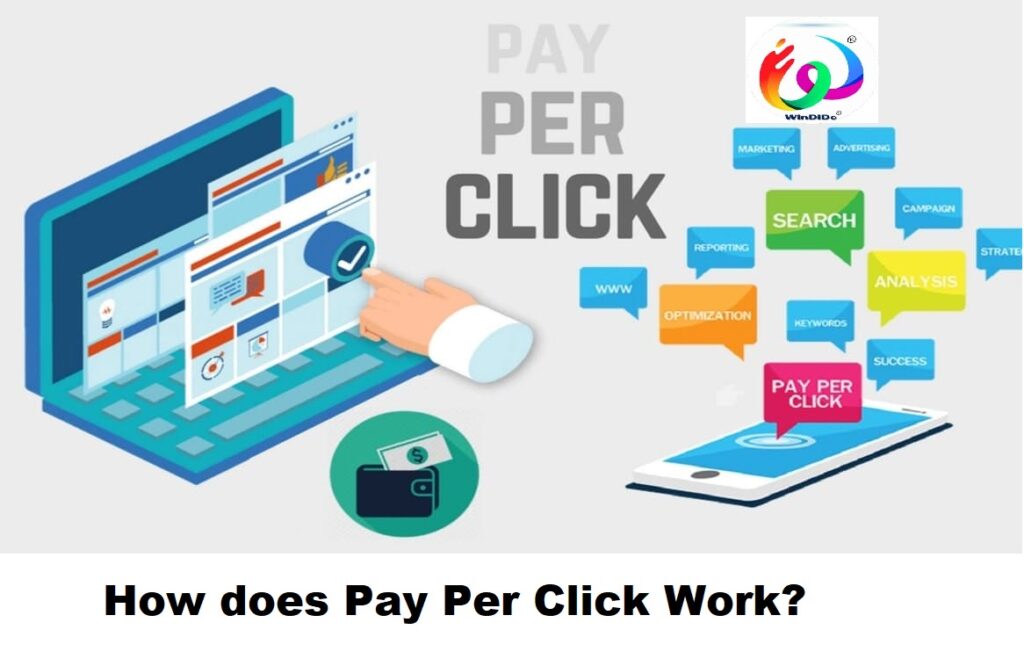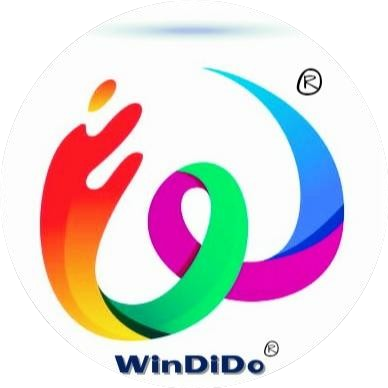How does Pay Per Click Work?
How does Pay Per Click Work?

Pay Per Click (PPC) is a digital advertising model used to drive traffic to websites, where advertisers pay a fee each time their ad is clicked. It’s a way of buying visits to your site rather than attempting to “earn” those visits organically.
Here’s how PPC typically works:
- Setting up a Campaign: Advertisers create ads and select keywords or phrases relevant to their target audience. These keywords are what people might use when searching for products or services similar to what the advertiser offers.
- Auction System: When a user conducts a search using keywords chosen by the advertiser, search engines like Google, Bing, or social media platforms like Facebook, Twitter, and LinkedIn initiate an auction. This auction determines which ads appear in prominent positions on the search engine results page (SERP) or on the platform.
- Bid Amounts: Advertisers specify the maximum amount they’re willing to pay for each click on their ad. This bid amount, along with other factors like ad quality, relevance, and landing page experience, determines ad placement and visibility.
- Ad Rank: Search engines use a metric called Ad Rank to determine the order in which ads appear on the SERP. Ad Rank is calculated by multiplying the maximum bid by the Quality Score of the ad, which is determined by its relevance, expected click-through rate (CTR), and landing page experience.
- Ad Display: When a user enters a search query that matches the keywords targeted by the advertiser, the search engine displays relevant ads alongside the organic search results. The position and visibility of the ad depend on its Ad Rank.
- Pay Per Click: If a user clicks on the ad, the advertiser pays the search engine or platform the amount of their bid. If nobody clicks on the ad, the advertiser doesn’t pay anything, but their ad still gets exposure.
- Monitoring and Optimization: Advertisers continuously monitor the performance of their PPC campaigns, analyzing metrics such as click-through rate, conversion rate, cost per click, and return on investment (ROI). Based on these insights, they make adjustments to their keywords, ad copy, targeting, and bidding strategies to optimize campaign performance and achieve their advertising goals.
How the PPC Model Works
The PPC (Pay Per Click) model is a form of online advertising where advertisers pay a fee each time one of their ads is clicked. Here’s a detailed breakdown of how the PPC model works:
- Ad Creation: Advertisers create ads that are typically displayed on search engines (like Google, Bing) or on social media platforms (like Facebook, Twitter, LinkedIn). These ads can take various formats, including text ads, display/banner ads, video ads, or product listings.
- Keyword Selection: Advertisers select keywords or phrases that are relevant to their products, services, or target audience. These keywords determine when their ads will be displayed. For example, a shoe retailer might choose keywords like “running shoes” or “athletic footwear.”
- Bidding: Advertisers participate in an auction where they bid on the amount they are willing to pay for each click on their ad. The bid amount represents the maximum price the advertiser is willing to pay. Higher bids increase the chances of the ad being displayed prominently.
- Ad Rank Calculation: Search engines and social media platforms use a combination of bid amount and ad quality to determine the ad’s position and visibility. Ad quality is determined by factors such as ad relevance, expected click-through rate (CTR), landing page experience, and ad format.
- Ad Display: When a user performs a search query or engages with content relevant to the selected keywords, the search engine or platform runs an auction to determine which ads will be displayed. The ads are then shown to users either alongside search results (in the case of search engines) or within the platform’s content feed (in the case of social media).
- User Interaction: If a user finds an ad relevant and clicks on it, they are directed to the advertiser’s website or landing page. The advertiser is charged the amount of their bid for that click.
- Budget Management: Advertisers set daily or campaign-level budgets to control their spending on PPC advertising. Once the budget is exhausted or the campaign period ends, the ads stop being displayed until the advertiser replenishes the budget or restarts the campaign.
- Performance Monitoring and Optimization: Advertisers continuously monitor the performance of their PPC campaigns using various metrics such as click-through rate (CTR), conversion rate, cost per click (CPC), and return on investment (ROI). Based on the performance data, advertisers make adjustments to their keyword selection, ad copy, targeting, and bidding strategies to optimize campaign performance and achieve their advertising goals.
Pay-Per-Click Models
Pay-per-click (PPC) advertising encompasses various models that advertisers use to pay for their ads. Here are some common PPC models:
- Search Advertising: This is the most prevalent form of PPC advertising. Advertisers bid on keywords relevant to their business, and their ads appear alongside search engine results when users search for those keywords. Google Ads (formerly known as Google AdWords) is the most popular search advertising platform.
- Display Advertising: Display advertising involves placing visual ads, such as banners, images, or videos, on websites, apps, or social media platforms. Advertisers pay based on the number of clicks or impressions (known as cost per mille or CPM) their ads receive. Google Display Network, Facebook Ads, and Instagram Ads are examples of platforms offering display advertising.
- Remarketing/Retargeting: Remarketing allows advertisers to target users who have previously visited their website but did not convert into customers. Advertisers use cookies or tracking pixels to display targeted ads to these users as they browse other websites or use social media platforms.
- Shopping Ads: Shopping ads, also known as Product Listing Ads (PLAs), allow e-commerce businesses to promote their products directly within search engine results. These ads typically include an image, product title, price, and store name. Advertisers pay when users click on the ad and are directed to the product page.
- Social Media Advertising: Social media platforms like Facebook, Instagram, Twitter, LinkedIn, and Pinterest offer PPC advertising options. Advertisers can target specific demographics, interests, behaviors, and locations to reach their desired audience. They pay based on clicks, impressions, or specific actions such as video views, app installs, or form submissions.
- Video Advertising: Video advertising involves placing ads within online videos on platforms like YouTube, Facebook, Instagram, and LinkedIn. Advertisers can pay based on views, clicks, or impressions. Video ads can be skippable or non-skippable and may appear before, during, or after the main video content.
- App Advertising: App advertising allows developers to promote their mobile apps within other apps or on mobile websites. Advertisers pay when users click on the ad or install the app. Platforms like Google Ads, Apple Search Ads, and mobile ad networks facilitate app advertising campaigns.
What Is PPC? Learn the Basics of Pay-Per-Click (PPC) Marketing
PPC, or Pay-Per-Click, is a digital marketing model where advertisers pay a fee each time one of their ads is clicked. It’s a way of buying visits to your site rather than attempting to “earn” those visits organically.
Here are the basics of PPC marketing:
- Ad Placement: PPC ads appear on search engines like Google, Bing, and social media platforms like Facebook, Twitter, LinkedIn, and Instagram. They can also be displayed on websites through display networks.
- Keyword Targeting: Advertisers select specific keywords or phrases related to their products or services. When users search for those keywords, the ads are displayed, making them highly targeted.
- Auction-based System: PPC operates on an auction-based system, where advertisers bid on the amount they are willing to pay for a click on their ads. Ad placement is determined by bid amount, ad quality, and other factors.
- Ad Rank: Advertisers’ ads are ranked based on their bid amount and ad quality. Quality Score, a metric used by platforms like Google Ads, takes into account ad relevance, expected click-through rate (CTR), and landing page experience.
- Ad Formats: PPC ads come in various formats, including text ads, display/banner ads, product listings (for e-commerce), and video ads. Advertisers can choose the format that best suits their marketing objectives and target audience.
- Budget Control: Advertisers set a daily or campaign-level budget to control their spending on PPC advertising. Once the budget is exhausted, the ads stop running until the advertiser replenishes the budget.
- Measurable Results: PPC offers advertisers detailed performance metrics, such as impressions, clicks, click-through rate (CTR), conversion rate, and return on investment (ROI). This allows advertisers to track the effectiveness of their campaigns and make data-driven decisions.
- Optimization: Advertisers continuously optimize their PPC campaigns by adjusting keyword targeting, ad copy, bidding strategies, and landing pages to improve performance and achieve their advertising goals.
How does PPC advertising work?
PPC (Pay-Per-Click) advertising is a digital marketing model where advertisers pay a fee each time their ad is clicked. It’s a way of buying visits to your site rather than attempting to “earn” those visits organically.
Here’s how PPC advertising works:
- Ad Creation: Advertisers create ads tailored to their target audience, products, or services. These ads can include text, images, videos, or product listings, depending on the platform and ad format.
- Keyword Selection: Advertisers choose keywords or phrases related to their business that they believe potential customers would use when searching for products or services online. These keywords determine when and where the ads will appear.
- Bidding: Advertisers participate in auctions conducted by advertising platforms such as Google Ads, Bing Ads, or social media platforms like Facebook Ads and Twitter Ads. In these auctions, advertisers bid on the maximum amount they’re willing to pay for a click on their ad.
- Ad Placement: When users perform a search query or visit a website or social media platform, the advertising platform evaluates the advertisers’ bids, ad quality, and relevance to determine which ads to display and in what order.
- Ad Display: If an advertiser’s bid is competitive and their ad is relevant to the user’s search query or interests, the ad may appear in prominent positions on search engine results pages (SERPs), websites, or social media feeds.
- User Interaction: When a user clicks on the ad, they’re directed to the advertiser’s website, landing page, or app. The advertiser pays the advertising platform the amount of their bid for that click.
- Budget Management: Advertisers set daily or campaign-level budgets to control their spending on PPC advertising. Once the budget is exhausted, the ads stop appearing until the advertiser replenishes the budget.
- Performance Monitoring and Optimization: Advertisers monitor the performance of their PPC campaigns using metrics such as click-through rate (CTR), conversion rate, cost per click (CPC), and return on investment (ROI). Based on performance data, advertisers adjust their keyword targeting, ad copy, bidding strategies, and landing pages to optimize campaign performance and achieve their advertising goals.
#entrepreneurship #follow #love #photography #affiliatemarketing #businessowner #webdevelopment #content #like #art #b #emailmarketing #fashion #instagood #websitedesign #google #digitalmarketingstrategy #marketingonline #socialmediamanager #searchengineoptimization #facebook #digitalmarketer #empreendedorismo #workfromhome #copywriting #instagrammarketing #digitalagency #brand #digitalmarketingexpert #windido.
